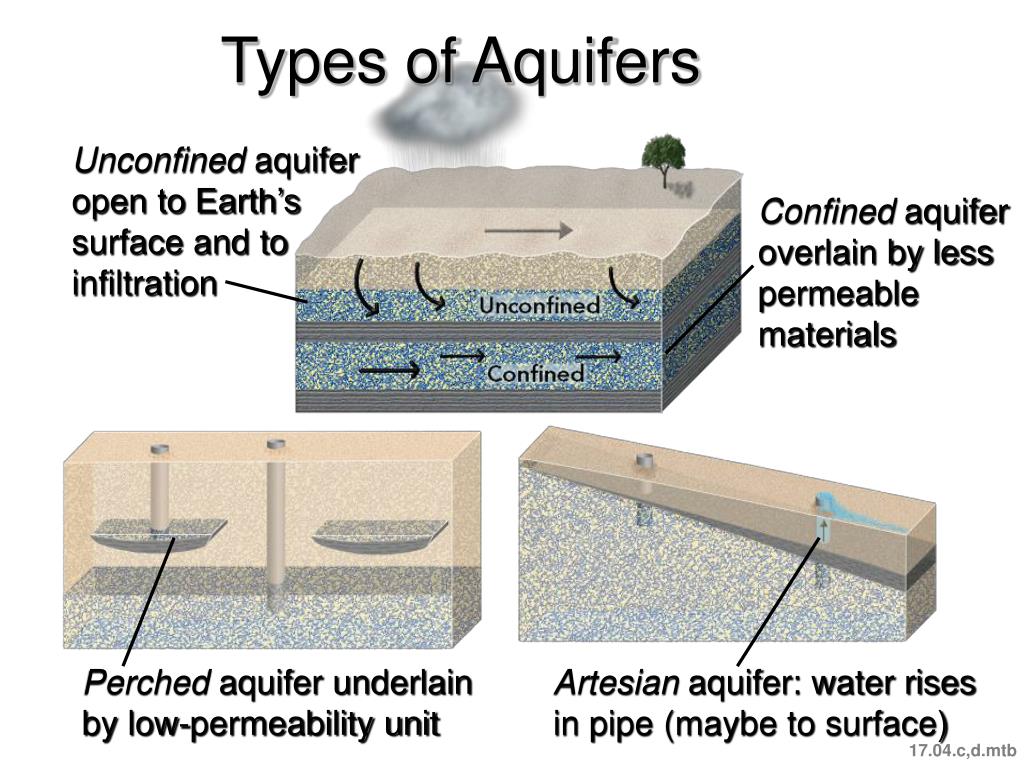An aquifer is a fundamental component of the Earth’s subsurface that plays a crucial role in providing fresh water for various purposes, including drinking, agriculture, and industry. It is a geological formation or underground layer of rock, sand, gravel, or other materials that can store and transmit water. Aquifers act as natural reservoirs for groundwater, which is the water present beneath the Earth’s surface.
Key characteristics of aquifers include:
Water Storage in Aquifers:
Aquifers are natural underground reservoirs that play a crucial role in storing and providing water. They hold significant quantities of water, primarily sourced from precipitation that has infiltrated the ground. This process, known as infiltration, involves rainwater or melted snow seeping into the earth’s subsurface, where it percolates through layers of soil and rock to reach aquifers.
Aquifers consist of porous and permeable materials that allow water to move freely through them. As water infiltrates, it gradually fills these underground formations. The stored water in aquifers is essential for various purposes, including:
- Groundwater Supply:
Aquifers serve as a vital source of groundwater, which is tapped through wells for drinking water, irrigation, and industrial use.
- Natural Springs:
Some aquifers feed natural springs, contributing to the flow of freshwater in rivers and streams.
- Environmental Balance:
Maintaining the water stored in aquifers helps sustain wetlands, ecosystems, and the overall environmental balance.Understanding the role of aquifers in water storage is crucial for managing and conserving this valuable resource, ensuring a sustainable supply of freshwater for both human needs and nature.
Permeability in Aquifers:
Permeability is a fundamental property of aquifers that governs the movement of water within these underground formations. Aquifers are composed of materials such as rock, rock fractures, or unconsolidated materials like gravel, sand, or silt, and their permeability determines how easily water can flow through them.
High permeability in aquifers means that the materials have the ability to transmit water effectively, allowing it to move from one location to another. This property is crucial for several reasons:
- Groundwater Flow:
High permeability enables the efficient flow of groundwater within aquifers, making them significant sources of fresh water.
- Aquifer Recharge:
When precipitation infiltrates the ground, aquifers with high permeability can quickly recharge, storing the newly added water.
- Well Productivity:
Wells drilled into high-permeability aquifers yield more water, making them valuable for water supply.
- Environmental Impact:
Permeability influences the interaction between groundwater and surface water, affecting the health of ecosystems and the flow of rivers and streams.
Understanding the permeability of aquifers is essential for managing water resources, ensuring a sustainable water supply, and protecting the environment.
Aquifer Types:
Aquifers are underground layers of rock or sediment that store and transmit groundwater. They come in various types, each with distinct characteristics that impact how water is stored and accessed. Here are the main types of aquifers:
- Confined Aquifers:
These aquifers are bounded by impermeable materials, such as clay or shale, both above and below the aquifer. The confinement restricts the movement of water, resulting in increased pressure. When a well is drilled into a confined aquifer, the water often rises above the aquifer’s upper boundary, creating artesian conditions.
- Unconfined Aquifers:
Unlike confined aquifers, unconfined aquifers have permeable material both above and below them, allowing water to move freely. The water table in unconfined aquifers is at atmospheric pressure, and the water level can fluctuate with precipitation and extraction.
- Artesian Aquifers:
Artesian aquifers are confined aquifers with enough pressure to force water to rise above the upper boundary without the need for pumping. When a well is drilled into an artesian aquifer, water flows to the surface on its own due to the natural pressure.
Understanding these aquifer types is essential for effectively managing groundwater resources and ensuring sustainable water supplies.
Water Extraction from Aquifers:
Aquifers serve as valuable sources of groundwater, which can be extracted for various human purposes. Wells are typically drilled into aquifers to access this groundwater. The ease and effectiveness of extracting water from aquifers depend on several critical factors related to the aquifer’s properties. These factors include:
- Permeability:
Aquifers with high permeability allow water to flow more easily, making extraction simpler and yielding larger quantities of water.
- Depth and Thickness:
The depth and thickness of the aquifer influence the feasibility of drilling wells. Shallow and thick aquifers are generally more accessible.
- Recharge Rate:
Aquifers that recharge quickly through precipitation or other sources provide a more sustainable water supply.
- Confinement:
Confined aquifers, which are surrounded by impermeable layers, may require less pumping effort due to natural artesian pressure.
- Water Quality:
Assessing water quality is crucial to ensure that the extracted groundwater meets safety and health standards.
- Environmental Considerations:
Sustainable water extraction practices must consider potential environmental impacts and the need for aquifer conservation.
Understanding these aquifer properties is essential for responsible groundwater management, ensuring a reliable and safe water supply for human use.
Sustainability of Aquifers:
The sustainability of aquifers is a critical concern in water resource management. Proper management practices are essential to ensure the long-term viability of these underground water sources. Failure to do so can result in various issues, including subsidence and saltwater intrusion.
Key considerations for aquifer sustainability include:
- Preventing Over-Extraction:
Over-pumping groundwater from aquifers can lead to the depletion of their reserves. Sustainable management involves regulating extraction rates to match natural recharge processes.
- Monitoring Water Levels:
Continuous monitoring of groundwater levels helps identify declining trends, enabling timely intervention to prevent excessive drawdown.
- Conservation Measures:
Implementing water conservation measures, such as efficient irrigation techniques and reduced water waste, can alleviate pressure on aquifers.
- Subsidence Prevention:
Over-extraction can cause land subsidence as underground voids fill with air. This subsidence can damage infrastructure and reduce aquifer storage capacity.
- Saltwater Intrusion Control:
Along coastal areas, excessive groundwater pumping can allow saltwater to intrude into freshwater aquifers, rendering them unusable. Managing extraction rates is crucial to prevent this.
- Community Engagement:
Educating and involving local communities in sustainable water use practices fosters responsible groundwater management.
Environmental Impact of Aquifers:
Aquifers play a pivotal role in the environment, impacting ecosystems and the availability of freshwater resources. Understanding their significance and proper management is essential for safeguarding the environment and ensuring a sustainable water supply for future generations.
Key aspects of the environmental impact of aquifers include:
- Ecosystem Health:
Aquifers influence the health of ecosystems by providing a source of groundwater that sustains wetlands, rivers, and streams. These water bodies are critical habitats for numerous species and rely on aquifers for their flow and maintenance.
- Surface Water Flow:
Aquifers can significantly affect the flow of surface water. They serve as natural springs that feed rivers and streams, contributing to the overall hydrological balance.
- Wetland Preservation:
Wetlands, essential for biodiversity and flood control, often depend on aquifer-fed groundwater to maintain their water levels and ecological functions.
- Water Quality:
Aquifer health directly impacts water quality. Contaminants that infiltrate aquifers can degrade the quality of groundwater, posing risks to both ecosystems and human consumption.
- Sustainable Management:
Proper aquifer management, including monitoring water levels and controlling extraction, is vital to prevent over-extraction that can harm ecosystems and lead to land subsidence.
In summary, aquifers are not only crucial sources of freshwater for human use but also integral components of ecosystems and environmental stability. Protecting and managing aquifers sustainably is essential for preserving the health of our planet and ensuring a reliable water supply for future generations.

